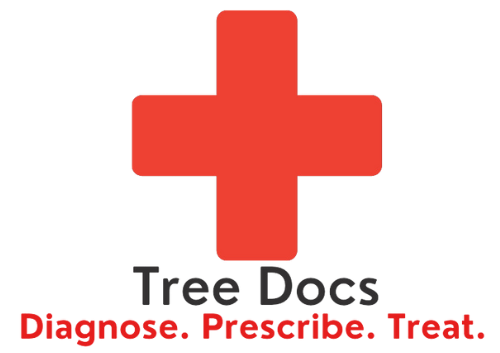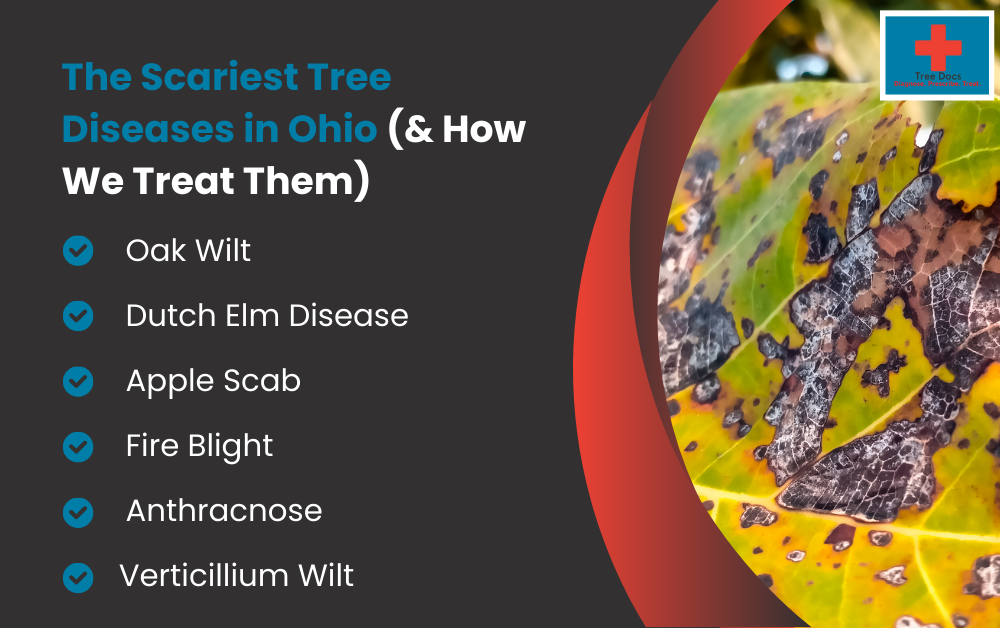October is the season of spooky stories, haunted houses, and eerie surprises—but nothing sends more chills down a homeowner’s spine than discovering that a beloved tree is dying from disease. While ghouls and goblins are only around for one night, tree diseases are real, destructive, and capable of turning a strong, healthy tree into a dangerous liability.
In Ohio, our climate and mix of native species create the perfect environment for several destructive diseases to thrive. From infections that spread silently underground to blights that leave branches scorched overnight, these problems can transform your yard from beautiful to barren in just a season. Fortunately, when identified early and treated properly, most diseases can be managed—and your trees can be saved.
Let’s take a closer look at the scariest tree diseases in Ohio, how we diagnose them, and what treatments make a real difference.
Why Tree Diseases Are a Serious Threat
Hidden Dangers in Your Yard
Most tree diseases don’t show dramatic symptoms at first. A slight discoloration, a small cluster of dying leaves, or a few branches that look “off” can quickly escalate. Left unchecked, infections can travel through roots, bark, and foliage until the tree’s health is compromised beyond repair.
The Cost of Ignoring Infections
When homeowners overlook these warning signs, the cost goes beyond the tree itself. Diseased trees are weaker and more prone to dropping branches—especially during Ohio’s harsh fall storms and icy winters. That creates risks for homes, vehicles, and anyone walking nearby. Even worse, emergency removal of a diseased tree often costs more than early treatment.
Environmental Impact
Losing a tree doesn’t just affect your property—it affects your ecosystem. Trees provide shade, prevent soil erosion, improve air quality, and serve as habitats for countless species. Once a tree disease spreads through a neighborhood or forested area, the environmental loss can be devastating.
The Scariest Tree Diseases in Ohio
Oak Wilt – The Silent Killer
Oak wilt is one of the most feared tree diseases in Ohio. Red oaks, in particular, can die within weeks of infection. Symptoms start with browning leaves at the top of the tree, progressing downward until the tree is bare. The disease spreads underground through root connections and above ground through beetles that feed on sap. Once established, oak wilt can quickly spread through entire oak stands.
Dutch Elm Disease – A Historic Nightmare
Dutch elm disease has wiped out millions of elm trees across North America. It’s caused by a fungus spread by elm bark beetles, leading to wilting, yellowing leaves, and branch dieback. For homeowners who still have elm trees, the disease is a constant threat. Infected trees often require aggressive pruning, trunk injections, or, in severe cases, removal to protect nearby trees.
Apple Scab – The Ugly Truth for Fruit Trees
Apple scab is one of the most common tree diseases affecting ornamental crabapples and fruit-bearing apple trees in Ohio. The disease causes dark, scabby lesions on leaves and fruit, leading to early leaf drop and poor fruit production. While rarely fatal, it significantly weakens trees and ruins their appearance. Homeowners often notice bare branches in midsummer when apple scab takes hold.
Fire Blight – A Fast-Moving Infection
Fire blight is as dramatic as it sounds. Caused by bacteria, it gives branches a scorched, burned look—like they’ve been touched by flames. It primarily affects pears, apples, and crabapples. Because the disease spreads quickly in warm, humid conditions, it often appears in late spring and early fall. If not managed, fire blight can spread through entire orchards or landscapes.
Anthracnose – The Leaf Destroyer
Anthracnose is a fungal disease that affects many shade trees, including maples, oaks, and sycamores. It causes brown blotches on leaves and leads to early defoliation. While it rarely kills mature trees outright, repeated infections weaken them and make them vulnerable to other pests and diseases. For homeowners, it often looks like their tree “gave up” halfway through summer.
Verticillium Wilt – The Invisible Threat
Verticillium wilt is particularly concerning because it lives in the soil. This fungus clogs a tree’s vascular system, preventing water and nutrients from reaching the leaves. Symptoms include yellowing foliage, sudden wilting, and branch dieback. Because it’s soil-borne, it can persist for years and infect multiple trees in the same area. Without proper treatment, verticillium wilt often goes unnoticed until a tree is too far gone.
How Tree Docs Diagnoses Tree Diseases
Certified Arborists on Call
At Tree Docs, diagnosis starts with expertise. Our certified arborists are trained to spot the subtle signs of disease that most homeowners would miss. From leaf patterns to bark abnormalities, their trained eyes help identify problems before they become catastrophic.
Advanced Tools & Testing
Sometimes visual inspection isn’t enough. That’s why we use advanced diagnostic tools and laboratory testing when needed. Soil samples, tissue analysis, and root inspections allow us to pinpoint the exact cause of decline and recommend the right treatment.
Tailored Treatment Plans
Every tree, every property, and every disease is unique. That’s why we don’t believe in one-size-fits-all solutions. Instead, we build customized care plans that target the specific disease while strengthening the overall health of your trees.
Treatment Options for Tree Diseases in Ohio
Pruning & Removal of Infected Areas
One of the simplest yet most effective treatments is careful pruning. By removing infected limbs and branches, we can prevent many tree diseases from spreading further. In severe cases, complete removal of a tree may be necessary to protect surrounding trees.
Soil & Root Health Treatments
Strong roots equal strong trees. We offer soil aeration, deep root fertilization, and organic amendments to improve root function and give trees the nutrients they need to fight infections.
Fungicides & Injections
Certain fungal diseases respond well to fungicide treatments or direct injections into the tree’s vascular system. These methods are precise and allow us to treat the disease without damaging the surrounding environment.
Long-Term Care Plans
Diseases don’t disappear after one treatment. That’s why we recommend ongoing care plans that include monitoring, seasonal checkups, and preventive treatments. By staying ahead of the curve, we can protect your investment and keep your landscape thriving.
Prevention Is the Best Cure
Regular Inspections
Annual inspections from a certified arborist are the first line of defense. Catching a disease early often means the difference between saving and losing a tree.
Proper Pruning Practices
Poor pruning can create open wounds that act as entry points for diseases. Professional pruning ensures cuts are clean and minimize infection risks.
Seasonal Fertilization & Soil Care
Trees that receive proper nutrition are more resilient against disease. Fall fertilization, in particular, prepares trees for the stress of winter and boosts immunity for the following spring.
Choosing Resistant Tree Varieties
When planting new trees, selecting disease-resistant varieties can save headaches down the road. Our team can recommend the best options for Ohio’s climate.
Don’t Let Tree Diseases Haunt Your Yard
This October, while ghosts and goblins roam the neighborhood, the real fright might be lurking in your yard: tree diseases. From oak wilt and Dutch elm disease to fire blight and verticillium wilt, Ohio’s trees face threats that can strike quickly and spread silently. The good news? With the right care, most diseases can be managed, and your trees can be preserved for generations.
Don’t let tree diseases haunt your property. At Tree Docs, our certified arborists are here to diagnose, treat, and protect your trees before it’s too late. Call us today at 330-523-6585 or schedule your inspection online to keep your landscape healthy, safe, and beautiful year-round.



